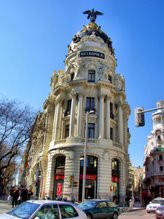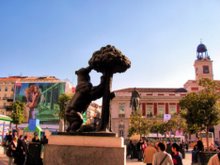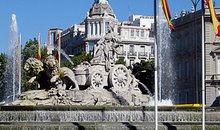
Wagner is back at the Teatro Real with “The Flying Dutchman” or thats “Der fliegende Holländer” in German to you. One of his shorter operas in comparison to the usual five hours I've sat through whenever I've gone to a Wagner opera.
Full of Romantic, 19th century ideals, “The Flying Dutchman” tells the story of a cursed sea-captain doomed to sail the seas for eternity; every seven years he gets a day off when set foot on land, so like every horn-dog sailor he searches for a woman. But the Dutchman is no randy seaman as he he searching for a good wife who will be faithful to him till “death do us apart”, through her loyalty he'll find salvation.
With movie-like titles projected onto the curtain announcing that the opera “Der fliegende Holländer” by Richard Wagner is about to start, the music resonates throughout the auditorium. The opera opens with Act I, set in the North Sea off the coast of Norway. A projection of waves are seen in the background, and the stage is set to look like a modern day Nordic fishing boat – at the moment the setting is simple but effective. Daland, the ships captain, goes off for a nap leaving his helmsman in charge of keeping watch. The tenor, Vincente Ombuena, sings the song of the helmsman which is passionate and lyrical dedicated to his beloved back at home, it is full of nostalgia and longing. The helmsman is not a very good watchman as he falls asleep pretty quickly on duty. While he slumbers a large ship is projected moving into the background to obscure the wave, effective and dramatic effect which moves in time to the music. The large white letters on a rust background fade into view with the words “HOLLANDER” on it, a little bit tacky since it just means “Dutchman” in German, however most people wont know this so this is a forgivable mistake.
Our Dutchman comes on the scene, oddly staged on the platform below despite the little ship being raised above - his ship is supposed to be bigger and therefore wouldn't he be above? Danish baritone Johan Reuter laments his story of damnation to moving lyric of Wagner's music with a strong voice and subtle charisma fitting of this tormented hero. His yearns are convincing and we empathise with his instantly with his woes.
Daland (Hans-Peter König) finds the watchman doing his job; but that's the least of his worries when he sees a great big boat parked right next to him. Daland calls to the alien ship, and its captain reveals himself to be a Dutchman. He makes his big entrance down a rusty plank (again oddly staged since before we saw him down below) and reveals to Daland that he is loaded with precious jewels and gemstones. The Dutchman wastes no time in asking the captain if he has an unmarried daughter, and by the convenience of fiction and drama he: a beautiful, young and single daughter. Daland is a bit struck for cash and agrees that his daughter to be married off to the pale foreigner with the big rusty boat for a packet of gems. The Dutchman is excited at not only about finally getting a woman after years going insane at sea - but more importantly for the loyal wife who would break his curse.
Act II opens with a chorus of women in a fish factory, and a very dreamy looking Senta walks around carrying a little boat with red sails. She is soon joined by Mary, who in this production plays some kind of manager of the factory and suffers an identity crisis of being a young woman who wants to dress like a frumpy matron with terrible clothes and good make up, although German Mezzo-Soprano Nadine Weissman plays the role convincingly considering what she was allowed to work with, but at least her fabulous voice was allowed to shine through.
Senta tells her and the other women about the legend of the Flying Dutchman – this man damned to sail the seas in an eternity in boredom and despair. She naively wishes it to be her destiny to become his loyal wife and salvation – I guess she'll be happy at what Daddy is bringing her home then. German Soprano Anja Kampe sings the ballad with Leitmotiv beautifully and with great clarity, but the attention to her remarkable voice is distracted by a small object moving up on the wires. Even sitting in the 3rd row down in front I had trouble trying to discern what this object was... soon I realised it was a tiny toy boat, and I experienced deja vu back to the Stonehenge scene in This is Spinal Tap – having a spoof heavy metal go off in my brain while I tried to concentrate on Wagner was rather distracting.
Senta's ex Eric (Stephen Gould) over hears her passionate desires and is upset; he tells Senta of his dream that her father came back with a stranger from the sea for her to marry - he should get himself a tent and a crystal ball and charge people money with insightful talent like that. Surprise, surprise – Daland comes home with a new gift for Senta, a brand new husband who she doesn't know, fortunately it's love at first sight between the two. There is little acting or physical interaction between Senta and the Dutchman, but there is chemistry between them which electrifies the air. The look they give each other is genuine, but understated. A curiosity, an interest and a cautiousness between these two strangers. The execution between the two singers is excellent, it is subtle and effective – so why did the director place two extras in the background making out when he had such a talented cast to work with I don't know. I guess he wanted to home in the point they were falling in love, but the effect was cheap. The duet between the Dutchman and Senta is sublime, with the passionate and erotic charge you only get from Wagner's music.
Act III. At this point the director drives me crazy. The curtain is down and the letters ACT III are projected the same as the past two acts, which is fine and clean, but having a random cyclist go across stage shortly followed by a gratuitous Labrador then followed by a group of girls who run after a guy stripping his clothes off; all so contrived and ill fitting to the music. It played no part in the plot or symbolism or music - just pure gimmickry. Also during the storm, already effectively executed by the wonderful chorus, the director sticks random naked women spazzing out behind glass windows in the background, for no reasons other than shock factor. I am not a prude. I do not mind nudity on stage, but if things are just shocking for no reason I find this a show of poor directing, trying to be “avant-guard” for the sake of it. The ending too is poorly staged when you see the Dutchman walk off stage via the rocks, followed by Senta declaring to save him and jumps off the rocks in the same direction – does she jump onto the boat or does she kill herself? It's left too dubious and makes me wonder if the director got confused thinking he was directing Tosca.
Overall musically the show is wonderful, the cast is intensely good and one of the very few productions I have seen where the entire cast is strong, the chorus too did a fantastic job. The music, conducted by Jesús López Cobos is also flawless and raw with emotion, sensuality and drama. Musically this is one of the best productions I have seen in a long time.
The staging – as you may have guessed – annoyed me. It is not the worst production I have seen. The general staging, not including the irrelevant and annoying gimmicks was OK, but just Ok The singers were not made to act, and it was evident that they could. The setting was bland and executed mediocre at best. This is a fascinating story and a lot could be done to bring it out, but it's a sign of poor directing when the only way to follow the show is by keeping up with the subtitles. A pity as I like being able to follow the narrative from the stage and not just from skimming the libretto; the gimmicks just added insult to injury.
Overall I do highly recommend this production – if only for the talented cast and the wonderful music. I thoroughly enjoyed the two and a half hours of this production, but there is no interval so don't drink too much before going in. Definitely a must to check out if you are a Wagner fan or even new to Wagner as this is a nice introduction to the maestro.
Dates:14,15,17,19,20,22,23,24,26,27,28 of JanuaryLocation: Teatro Real, Plaza Oriente
Transport:Metro line 5,line 2, R (Opera) or line 1, line 3(Sol)
Prices:Without discount (16€-151€) ages 26 or under at last minute tickets get 90% off!
_01.jpg)












